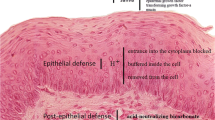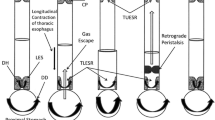Abstract
In this paper, the isolated influence of physical factors on the development of gastroesophageal reflux in man is analyzed by means of a mechanical model. We evaluate the influence of gravity, intraabdominal presure, intrathoraci pressure, transmission of intraabdominal pressure to the high pressure zone, filling volume of the stomach, and the existence of a high pressure zone on the appearance of gastroensophageal reflux. PH-metry is used to record the episodes of reflux in the model. We wish to demonstrate the importance of gravity and intraabdominal pressure in the production of reflux. Intrathoracic pressure acts as an antireflux mechanism only when associated with a zone of high pressure. The intraabdominal pressure may be transmitted to the high pressure zone as a purely mechanical effect and the greater gastric filling volume may, when associated with the intraabdominal pressure, facilitate reflux without physical changes in the high pressure zone (the equivalent of a reduction in the length of the lower esophageal sphincter in man). We conclude that this model may help to explain the influence of the physical factors mentioned above on the development of gastroesophageal reflux in man.
Similar content being viewed by others
References
Johnson F, Joelsson B, Gudmundsson K: Determinants of gastroesophageal reflux and their interrelationships. Br J Surg 76:241–244, 1989
Castell DO, Harris LD: Hormonal control of gastroesophageal sphincter strength. N Engl J Med 282:886–889, 1970
Dodds WJ, Hogan WJ, Miller WN, Stef JJ, Arndorfer RC, Lydon SB: Effect of increased intraabdominal pressure on lower esophageal sphincter pressure. Dig Dis 20:298–308, 1975
Giles GR, Mason MS, Humphries C, Clark CG: Action of gastrin on the lower esophageal sphincter in man. Gut 10:730–734, 1969
Bonavina L, DeMeester TR, Evander A: Role of the overall length of the distal esophageal sphincter in the antireflux mechanism. In: Siewert JR, Holscher AH (eds.): Diseases of the Esophagus. New York: Springer-Verlag, 1988
Pope CE II: A dynamic test of sphincter strength: its application to the lower esophageal sphincter. Gastroenterology 52:779–786, 1967
Ahtaridis G, Snape WJ, Cohen S: Lower esophageal sphincter pressure as an index of gastroesophageal reflux. Dig Dis Sci 26:993–998, 1981
Dodds WJ, Hogan WJ, Helm JF, Dent J: Pathogenesis of reflux esophagitis. Gastroenterology 81:376–394, 1981
Sicular A, Cohen B, Zimmerman A, Kark AE: The significance of an intra-abdominal segment of canine esophagus as a competent antireflux mechanism. Surgery 61:784–790, 1967
Allison PR: Peptic ulcer of the esophagus. J Thorac Surg 15:308–317, 1946
DeMeester TR: Prolonged oesophageal pH monitoring. In: Read NW (ed.): Gastrointestinal Motility: Which Test? Great Britain: Biomedical Publishing, 1989
Johnson LF, DeMeester TR: Twenty-four hour pH monitoring of the distal esophagus: a quantitative measure of gastroesophageal reflux. Am J Gastroenterol 62:325–352, 1974
Dent J, Dodds WJ, Friedman RH, Sekiguchi T, Hogan WJ, Arndorfer RC: Mechanism of gastroesophageal reflux in recumbent asymptomatic human subjects. J Clin Invest 65:256–267, 1980
Dent J, Dodds WJ, Hogan WJ, Toouli J: Factors that influence induction of gastroesophageal reflux in normal human subjects. Dig Dis Sci 33:270–275, 1988
Dodds WJ, Dent J, Hogan WJ, Helm JF, Hauser R, Patel GK, Egide MS: Mechanism of gastroesophageal reflux in patients with reflux esophagitis. N Engl J Med 307:1547–1552, 1982
Cohen S, Harris LD: Lower esophageal sphincter pressure as an index of lower esophageal sphincter strength. Gastroenterology 58:157–162, 1970
DeMeester TR, Lafontaine E, Joelsson BE, Skinner DB, Ryan J, O'Sullivan G, Brunsden B, Johnson LF: Relationship of a hiatal hernia to the function of the body of the esophagus and the gastroesophageal junction. J Thorac Cardiovasc Surg 82:547–558, 1981
Pellegrini CA, DeMeester TR, Wernly JA, Johnson LF, Skinner DB: Alkaline gastroesophageal reflux. Am J Surg 135:177–184, 1978
DeMeester TR, Wernly JA, Bryant GH, Little AG, Skinner DB: Clinical and in vitro analysis of determinants of gastroesophageal competence. Am J Surg 137:39–46, 1976
Marschall JB: Gastroesophageal reflux disease. Medical aspects. Postgrad Med 85:92–100, 1989
Rokkas T, Sladen GE: Ambulatory esophageal pH recording in gastroesophageal reflux: relevance to the development of esophagitis. Gastroenterology 83:629–632, 1988
Smout AJ, Van Der Zouw C, Akkermans LMA: Physiological gastroesophageal reflux and esophageal motor activity studied with a new system for 24-hour recording and automated analysis. Dig Dis Sci 3:372–378, 1989
Biancani P, Dodds J, Storer E, Selling J, McCallum RW: Acute experimental esophagitis affects mechanical properties of the lower esophageal sphincter. (Abstract). Gastroenterology 76:1100, 1978
Bonavina L, Evander A, DeMeester TR, Walther B, Cheng S, Palazzo L, Concannon J: Length of the distal esophageal sphincter and competency of the cardia. Am J Surg 151:25–33, 1986
Pettersson GB, Bombeck CT, Nyhus LM: The lower esophageal sphincter: mechanisms of opening and closure. Surgery 88:307–314, 1980
Clark CS: Gastroesophageal reflux induced by exercise in healthy volunteers. JAMA 261:3599–3601, 1989
Skinner DB, Belsey R, Management of Esophageal Disease. Philadelphia: WB Saunders, Co, 1988
Ahtaridis G, Snape WJ, Cohen S: Is the LES enough? Yes! Gastroenterology 76:1090, 1978
Cohen S, Harris LD: Does hiatus hernia effect competence of the gastroesophageal sphincter? N Engl J Med 284:1053–1056, 1971
DeMeester T, Johnson LF, Guy JJ, Toscano M, Hall A, Skinner D: Patterns of gastroesophageal reflux in health and disease. Ann Surg 184:459–470, 1976
Fyke FE Jr, Code CF, Schelegel JF: The gastroesophageal sphincter in healthy human beings. Gastroenterology 86:135–150, 1956
Liebermann-Meffert D, Allgower M, Schmid P, Math D, Blum AL: Muscular equivalent of the lower esophageal sphincter. Gastroenterology 76:31–38 1979
Johnson F, DeMeester TR: Evaluation of elevation of the bed, bethanechol, and antacid foam tablets on gastroesophageal reflux. Dig Dis Sci 26:673–680, 1981
Babka JC, Hager GW, Castell DO: The effect of body position on lower esophageal sphincter pressure. Dig Dis 18:441–442, 1973
Joelsson BE, DeMeester TR, Skinner DB, Lafontaine E, Waters PF, O'Sullivan G: The role of the esophageal body in the antireflux mechanism. Surgery 92:417–424, 1982
Davidson BR, Hurd DM, Johnstone MS: Nissen fundoplication and pyloroplasty in the management of gastro-oesophageal reflux in children. Br J Surg 74:488–490, 1987
Papaila JG, Wilmot D, Grosfeld JL, Rescorla FJ, West KW, Vane DW: Increased incidence of delayed gastric emptying in children with gastroesophageal reflux. A prospective evaluation. Arch Surg 124:933–936, 1989
Schwizer W, Hinder RA, DeMeester TR: Does delayed gastric emptying contribute to gastroesophageal reflux disease? Am J Surg 157:74–81, 1989
Kaye MD, Jhonson WP, Schowalter JP: Responses of the competent and incompetent lower oesophageal sphincter to pentagastrin and abdominal compression. Gut 17:933–939, 1976
Lind JF, Warrian WG, Wankcling WJ: Responses of the gastroesophageal junction zone to increases in abdominal pressure. Can J Surg 9:32–38, 1966
Ogilvie AL, Atkinson M: Influence of the vagus nerve upon the reflex control of the lower esophageal sphincter. Gut 25:253–258, 1984
Boesby S: Relationship between gastro-oesophageal acid reflux, basal gastroesophageal sphincter pressure, and gastric acid secretion. Scand J Gastroenterol 12:547–551, 1977
Ekstroem TR, Tibbling LI: Can mild bronchospasm reduce gastro-esophageal reflux? Am Rev Respir Dis 139:52–55, 1989
Author information
Authors and Affiliations
Rights and permissions
About this article
Cite this article
Sanz, R.G., González, E.M., González, J.S. et al. Influence of physical factors on the development of gastroesophageal reflux in man: Analysis by means of an experimental mechanical model. Dysphagia 9, 26–34 (1994). https://doi.org/10.1007/BF00262756
Issue Date:
DOI: https://doi.org/10.1007/BF00262756




